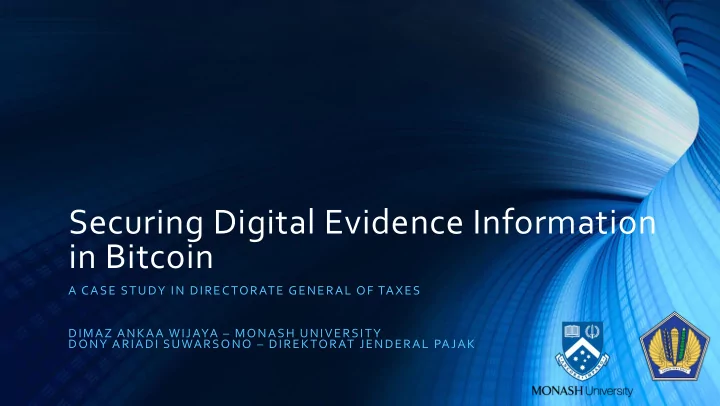

Securing Digital Evidence Information in Bitcoin A CASE STUDY IN DIRECTORATE GENERAL OF TAXES DIMAZ ANKAA WIJAYA – MONASH UNIVERSITY DONY ARIADI SUWARSONO – DIREKTORAT JENDERAL PAJAK
CV – Dimaz Ankaa Wijaya • Education • FMIPA UGM – Sarjana Komputer (2007) • Faculty of IT, Monash University – Master of Networks and Security (2016) • Field of Expertise • Digital Forensic, Database, software engineering • Network security, software security, cryptocurrency • Book • Mengenal Bitcoin dan Cryptocurrency (2016, Puspantara) • Contact • http://kriptologi.com • dimaz@kriptologi.com
Content • INTRODUCTION • THE PROPOSED METHOD • EVALUATION
Introduction
Bitcoin • Cryptocurrency - Digital payment system • Created by Satoshi Nakamoto in 2008 • No Trusted Party / central authority e.g. bank • Relies on cryptographic methods • Decentralized system – distributed ledger • Visible transaction history • Blockchain infrastructure • Infeasible to tamper the data
Tax Fraud Preliminary Investigation • PMK-239/PMK.3/2014 and SE-23/PJ/2015/ • Digital Forensic Procedures for tax fraud preliminary investigation. • “Borrowing” digital data from taxpayers. • Official letter as proof of borrowing the data.
Problem • Official letter is a “trusted system” which is prone to fraud. • Not a tamper-proof system.
Contribution • Storing the hash values of digital evidence in Bitcoin transaction. • Timestamp. • Tamper-proof.
Related Works • Asset Management System by using Bitcoin. • Permanently record data to Bitcoin’s blockchain. • Null Data Transaction • Metadata information embedded in Bitcoin transaction
The Proposed Method
Bitcoin Address Generation • Each party creates a new public key pair. • Tax Auditor address: PRV_ADDR • Taxpayer address: VRF_ADDR • Tax Auditor as a Government official received the public key pair from a parent key pair owned by the Government by using hierarchical deterministic wallet scheme. • Government address: GOVT_ADDR
Verifying the Participants • Digital certificate created by MIT Media Lab. • Verifying the identity and the public key of each participant.
Data Insertion • Utilizing 2-of-2 multisignature. • (PRV_ADDR, VRF_ADDR) -> TX(GOVT_ADDR, BTC|HASH) • Inserting the hash value in the NULL DATA transaction. Tax Auditor Bitcoin Transaction Hash value Government Address Tax Payer
Evaluation
Limitation and Assumption • Could not stand against both parties cooperating to tamper the system. • Assuming that the digital certificate authority always behaves honestly. • Assuming that the Government (or anyone holding the GOVT_ADDR private key) always behaves honestly.
Security Evaluation • The non-repudiation characteristic of the digital signatures in the Bitcoin transaction relies on the unforgeability of Elliptic Curve Cryptography. • The data embedded in Bitcoin transaction proves that no information is tampered.
Performance and Transaction Fee • Both transactions can be confirmed in the same block. • A block in Bitcoin is created every 10 minutes (roughly). • The protocol requires 2 transaction, each requires 10,000 satoshis. Thus it needs 20,000 satoshis. • As per 31 May 2016, 20,000 satoshis were worth Rp 1,522.
Conclusion • The protocol provides a failsafe of data tampering case. • Future works: establishing a data holder for the Bitcoin address owner’s identity.
Recommend
More recommend